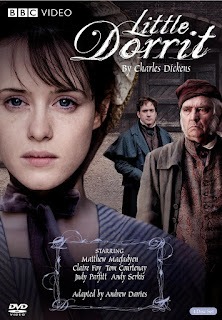Embracing failure, starting again
For Christmas, my husband gave me the set of Andrew Davies' film adaptation of Little Dorrit. I have never read the lengthy book by Charles Dickens. But I love the BBC version, starring Claire Foy, Matthew McFayden, Andy Serkis, and a large and excellent supporting cast.
In this work, Charles Dickens spun a complex tale of interwoven lives affected by the rise and fall of their financial situations. Dickens indicted such contemporary subjects as English bankruptcy law and debtors prisons as well as ancient themes like greed, waste, and contempt for the plight of the helpless. The author's own father spent a brief time in the Marshalsea debtors prison described so aptly in the book. The experience haunted him for the rest of his life.
Toward the end of the story, a protagonist, Arthur Clennam, finds himself in the Marshalsea. As the chief financial officer of a partnership, he has invested everything in a Ponzi scheme that collapses. Clennam hates himself for losing his partner's money. He thinks he will be unable to face his partner, Daniel Doyce, an inventor and mechanical genius.
Dickens does not, however, allow Clennam to languish in the prison, (mostly likely because Dickens wants a neat ending with Arthur and "little" Amy Dorrit married). Daniel Doyce returns from what we find out is a very successful business trip to Russia. He visits Arthur at the Marshalsea and offers a brief and profound speech on failure, forgiveness, and starting again.
The mechanical arts color the small excerpt of Daniel Doyce's speech below:
This is the type of passage that reminds us why Dickens is a master storyteller. His righteous character, Daniel Doyce, carefully and compassionately explains the logic behind forgiveness.
Without acknowledging our failures and being forgiven for them, we cannot move on.
There's an application in this morality play for the visual artist, also. Barney Saltzberg, author and illustrator of almost 50 children's books, covers this lesson in his new book, Beautiful Oops. I bought this board book for my four-year-old son, Alex, who loves to draw, paint, and work with clay.
XOXO,
Toward the end of the story, a protagonist, Arthur Clennam, finds himself in the Marshalsea. As the chief financial officer of a partnership, he has invested everything in a Ponzi scheme that collapses. Clennam hates himself for losing his partner's money. He thinks he will be unable to face his partner, Daniel Doyce, an inventor and mechanical genius.
Dickens does not, however, allow Clennam to languish in the prison, (mostly likely because Dickens wants a neat ending with Arthur and "little" Amy Dorrit married). Daniel Doyce returns from what we find out is a very successful business trip to Russia. He visits Arthur at the Marshalsea and offers a brief and profound speech on failure, forgiveness, and starting again.
The mechanical arts color the small excerpt of Daniel Doyce's speech below:
...'my dear Clennam,' said Doyce... First, not a word more from you about the past. There was an error in your calculations. I know what that is. It affects the whole machine, and failure is the consequence. You will profit by the failure, and will avoid it another time. I have done a similar thing myself, in construction, often. Every failure teaches a man something, if he will learn; and you are too sensible a man not to learn from this failure.'
This is the type of passage that reminds us why Dickens is a master storyteller. His righteous character, Daniel Doyce, carefully and compassionately explains the logic behind forgiveness.
Without acknowledging our failures and being forgiven for them, we cannot move on.
There's an application in this morality play for the visual artist, also. Barney Saltzberg, author and illustrator of almost 50 children's books, covers this lesson in his new book, Beautiful Oops. I bought this board book for my four-year-old son, Alex, who loves to draw, paint, and work with clay.
At the end of 2015, take some time to think about the "mistakes" that happened this year. As Saltzberg shows us, every bend, smudge, or tear can be something beautiful if we embrace the "oops" and look for beauty in the imperfect.
Before we get to 2016, think about embracing your failures.
Then, make 2016 about finding the beauty in this imperfect world!
Nicole





Comments
Post a Comment